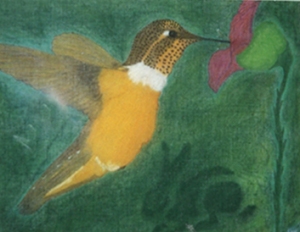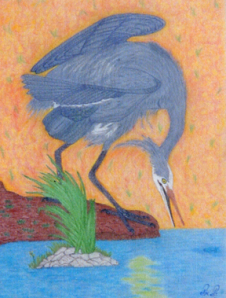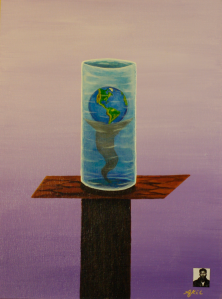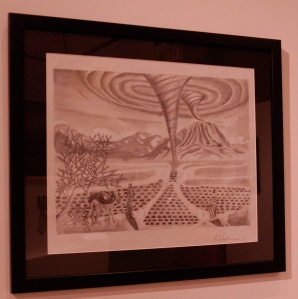Many people are surprised to learn that prisons today are overflowing with beautiful new art created by the prisoners themselves. But how do they manage this, under such difficult conditions? In an anthology coming out this August, Philosophy Imprisoned: The Love of Wisdom in the Age of Mass Incarceration, I describe what I think is true of all prison art, a phenomenon which I call it “self-torsion.” By this, I mean the process of attempting to torsion (or twist) yourself into a better version of yourself within institutions such as prisons (but also schools, mental institutions, and military bases) that channel those attempts into greater conformity and exploitation. What led me to search for this concept was being part of a reading group at Riverbend Maximum Security Prison in Nashville, Tennessee. While discussing all sorts of things in our group, from philosophy and religion to politics and the arts, I was surprised to learn that almost every imprisoned member of our group had years of experience creating art. And the more I experienced of their artworks, the more a kind of pattern began to emerge—but a pattern for which I could not seem to find the right name.
I eventually found that name in the writings of the greatest African-American theorist of the twentieth century, W. E. B. Du Bois, and probably the greatest French theorist of the same century, Michel Foucault. Du Bois had the idea of defining African-American art in order to promote social justice, by fighting the (often unconscious) propaganda of mainstream art (in favor of the status quo) with a new, self-conscious, liberating “propaganda.” In essence, by depicting social injustice directly, the creative resilience of the people who survive that injustice indirectly shines through, and beautifully. And Foucault had the (surprisingly complementary) ideas of ancient self-actualization and the soul-creating powers of modern imprisonment. For my part, then, I combined all three of these ideas to understand how today’s prisons encourage (mostly African-American and Latino) prisoners to recreate their own psyches in the interests of—not the prisoners themselves—but the prisons.
In other words, Du Bois was exhorting African-Americans to torsion themselves into the kind of artists whose work facilitates social justice. And Foucault was talking about prisons manipulating prisoners into torsioning themselves into the kind of prisoners who would be easier to control. Combining both with the Riverbend prisoners’ art, I realized that today’s predominantly African-American and Latino prisoners might be trying to carry out Du Bois’ positive torsion within the negative torsion of the prisons, and thereby illuminating for outsiders how the prisoners manage to still survive and create.
My primary image or metaphor for “self-torsion” derives from an image that (according to Foucault) the ancient Stoic philosophers’ used to describe a failed attempt at “care of the self,” namely a spinning top. The modification I introduced to reflect modern prison conditions is based on imagining this top as being made of a flexible material, affixed to the prison floor and forcefully spun until the top takes the shape of a household screw. Self-torsion, then, is the activity whereby is produced this maximally efficient tool for mass-produced construction based on homogeneous parts. In this way, self-torsion symbolizes how present-day institutions such as prisons fuse heterogeneous elements of an unjust society into exploitative order. And the redemptive and hopeful potential of self-torsion is that it reveals a creative defiance in the prisoners, which can inspire the outside world to take the necessary steps to ameliorate this terrible oppression.
Having thus found a name, self-torsion, for the pattern that emerged in the Riverbend prisoners’ art, I then returned to that art (in my chapter of Philosophy Imprisoned) to find out if the name rang true—and if so, to use self-torsion analyses of that art to continue Du Bois’ “propagandistic” project. Specifically, I analyzed two artworks by imprisoned artists in our reading group, Kennath Henderson’s “Solitary Confinement” and David Duncan’s “Do I Compel You?” Here, though, I will focus on four other artworks by Unit 2 insiders, presented at an art show at Vanderbilt University in January – February 2013 (entitled “Imagining Justice from the Inside Out”), and connected by two flying motifs: birds and tornadoes.
I begin with two pieces by Abu Ali Abdur’Rahman. First, “Hummingbird,” a pastel on a handkerchief, shows a hummingbird hovering to drink from a flower.
The most prominent and surprising feature here is the turquoise blue outline around the bird and flower, connecting them in a bright intensity. This blue is most prominent, however, behind the bird and around its wings—accentuated by several small streaks of blue—with the wings extending off the surface of the makeshift canvas. One infers from the clear lines of the painting that Abdur’Rahman has captured a frozen moment, since to the naked human eye a hummingbird’s wings flap far too quickly to be seen as individual body parts in flight. Moreover, biology tells us that this is the reason a hummingbird’s heart beats so much more rapidly than a human’s, which in turn causes it to exhaust itself into a comparatively premature death. In other words, even when just apparently hovering in place, a hummingbird beats the life out of itself, and so quickly that all we can see is a blur.
In terms of self-torsion then, the hummingbird—like the contemporary prisoner—contorts her/himself with a restless energy not fully visible to the outside, and thereby cuts her/his own life short. The otherwise superfluous blue light, then, I would suggest, is the trace of the activity of self-torsion, the flame burning in a blue heat with nowhere to go but the body which it destroys, albeit beautifully, in its very act of survival. This is not to deny, however, that there is life and creativity in this blue energy of self-torsion, but only that most of that creative light remains hidden in the prison’s manipulative twisting, until a moment such as this one, when the painting is shared with those on the outside.
Another of Abdur’Rahman’s pastels on handkerchief, “Crane,” offers a transition example between my avian and cyclonic themes, in that the dominant lines of the crane’s body and the sun reflected in the water suggest a swirling storm.
Again here, blue is prominent, connecting the bird to its source of sustenance; and again it is deployed in a more complex way in the animal (than the object of consumption). Note, more specifically, the various sinuous lines, the most prominent of which is curls into the crane’s body from the lower wing, up and over into a reverse letter “C,” and implicitly extending into a larger reverse “C” along the upper edge the crane’s body and down the right side of its neck—with its head making one final twisting curve in preparation to drink. Overall, one gets the sense of an elaborate, contorted effort, of an animal whose legs already abut the shore, moving up and down the crane’s height, along its graceful neck, and finally back down to the water. Self-torsion, again, is thus suggested by the curving lines of blue, which highlight the elaborate contortions to which the being is encouraged to subject itself just to survive. But in this case, it survives long enough to reach you and me with Abdur’Rahman’s creatively resilient life.
Birds also feature prominently in Abdur’Rahman’s “Hummingbird and Hibiscus,” Richard Odom’s “Crying Dove” and Dennis Suttles’ “Barnyard Scene,” but for reasons of space I will now finish the transition to my second theme, with Akil Jahi’s “As My World Turned,” in acrylic on canvas board.
Note the ecological reversal here, in which the tornado-type phenomenon is not within the world, affecting part of the earth, but instead taking the entire planet up into its spin. Similarly, in modern prisons, especially in death row facilities like Riverbend, chaos is more prominent than order. This is not to say that there is not a hyper-intensive micromanaging and compartmentalizing of the prisoners’ environment and existence, but rather that these elaborate and rigid rules can always be revoked or modified or intensified with no warning. In short, what appears from the outside as extreme order is, from the prisoners’ inside experience, chaotically arbitrary in its execution. Put differently, chaos takes all apparent order and reduces it to an infinite swirling, and one which is—crucially—displayed on a pedestal, much as contemporary prisons are erected as turbulent displays for the rest of modern society. In terms of self-torsion, the world of the prison is made to turn continuously for the benefit of its outside. This is not to say that there are no outlets of agency for the prisoners—that they may not force the manic winds to swirl in new patterns around them—but merely that there is no stable center from which they can act in a stable and cumulative way, since that center is more like an ever-moving target.
And on this note of agency, we are fortunate to have Jahi’s artist statement for the painting, which claims that his conscious intent was for the tornado to represent the various miseries his family faced prior to his entering prison. He also notes, however, that “As the World Turns” was not painted until thirty-five years later. Thus, it was inevitably shaped by the prison environment within which he reflected on experiences more than a generation past. I would suggest, then, that these prior experiences might have appeared more tornadic from within the tornadic world of the prison where the painting was born. Moreover, the reference toward the end of his statement to “our hardship” is sufficiently broad to encompass the hardships of his community at Riverbend as well.
In the final artwork I will consider here, LeMaricus Davidson’s “Holy Community” suggests an ecological reversal similar to “As My World Turned,” in that the two tornadoes are so large that they almost completely engulf the sky (as opposed to the sky being the larger environment in which the tornadoes are contained as mere parts of the whole). Also similar to the previous painting, these maximally destructive phenomena in “Holy Community” are placed such that the viewer views them from afar, from a relatively safe distance. Although the referent of the community is unclear (whether the orderly rows of dark mounds, or perhaps the cyclones themselves?), what is clear is the tension between holiness and deathliness in the community, and one which threatens to tear it apart.
This tension is one still faced by today’s prisons, and by a world outside which, as Du Bois and Foucault both predicted, is becoming ever harder to distinguish due to its arbitrary destruction of difference, minority voices. It is important to remember, however, that these voices have not yet been silenced completely, as evidenced in part by these four artworks, and by Jahi’s aforementioned artist’s statement. Abolition today is therefore more necessary than ever, while these voices can still be heard, for both the parts of our community behind prison walls, and the parts behind invisible ones. And one aspect of that abolition, as Du Bois advocated and Foucault implied, is the production, advocacy, and criticism of imprisoned art.
Toward that end, it is my hope that this concept of self-torsion may be of some “propagandistic” help, including for us on the outside to interrogate our own self-torsion from within an increasingly institutionalized global world. We who are committed to abolition must sound the call, to join the fight on all fronts—including the aesthetic—discovering and releasing wellsprings of creative agency, for all artists and thinkers, inside and out.
Joshua M. Hall is a visiting lecturer in philosophy at Muskingum University. Since earning his Ph.D. in 2012 from Vanderbilt University, he has coedited an anthology on philosophy’s relationship to prison (Philosophy Imprisoned) and published over a dozen peer-reviewed journal articles (including in Philosophy and Literature, Research in Phenomenology and Dance Chronicle). He also has a poetry chapbook collection entitled “Bachata Adobe” published by RedOchreLiT, over fifty individual poems (recently in Xavier Review, The Montucky Review and Euphony), and twenty years’ experience as a dancer and choreographer.



